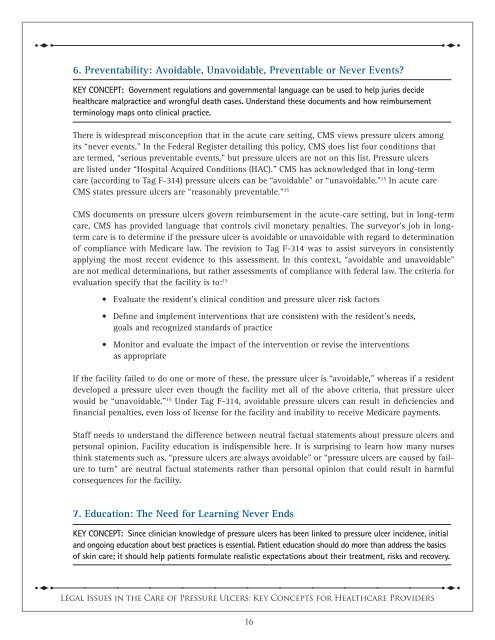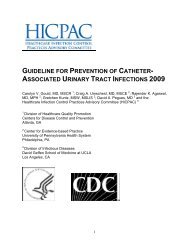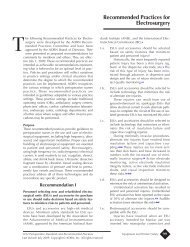stttttttttttts6. Preventability: Avoidable, Unavoidable, Preventable or Never Events?Key Concept: Government regulations and governmental language can be used to help juries decidehealthcare malpractice and wrongful death cases. Understand <strong>the</strong>se documents and how reimbursementterm<strong>in</strong>ology maps onto cl<strong>in</strong>ical practice.There is widespread misconception that <strong>in</strong> <strong>the</strong> acute care sett<strong>in</strong>g, CMS views pressure ulcers amongits “never events.” In <strong>the</strong> Federal Register detail<strong>in</strong>g this policy, CMS does list four conditions thatare termed, “serious preventable events,” but pressure ulcers are not on this list. <strong>Pressure</strong> ulcersare listed under “Hospital Acquired Conditions (HAC).” CMS has acknowledged that <strong>in</strong> long-termcare (accord<strong>in</strong>g to Tag F-314) pressure ulcers can be “avoidable” or “unavoidable.” 15 In acute careCMS states pressure ulcers are “reasonably preventable.” 35CMS documents on pressure ulcers govern reimbursement <strong>in</strong> <strong>the</strong> acute-care sett<strong>in</strong>g, but <strong>in</strong> long-termcare, CMS has provided language that controls civil monetary penalties. The surveyor’s job <strong>in</strong> longtermcare is to determ<strong>in</strong>e if <strong>the</strong> pressure ulcer is avoidable or unavoidable with regard to determ<strong>in</strong>ation<strong>of</strong> compliance with Medicare law. The revision to Tag F-314 was to assist surveyors <strong>in</strong> consistentlyapply<strong>in</strong>g <strong>the</strong> most recent evidence to this assessment. In this context, “avoidable and unavoidable”are not medical determ<strong>in</strong>ations, but ra<strong>the</strong>r assessments <strong>of</strong> compliance with federal law. The criteria forevaluation specify that <strong>the</strong> facility is to: 15• Evaluate <strong>the</strong> resident’s cl<strong>in</strong>ical condition and pressure ulcer risk factors• Def<strong>in</strong>e and implement <strong>in</strong>terventions that are consistent with <strong>the</strong> resident’s needs,goals and recognized standards <strong>of</strong> practice• Monitor and evaluate <strong>the</strong> impact <strong>of</strong> <strong>the</strong> <strong>in</strong>tervention or revise <strong>the</strong> <strong>in</strong>terventionsas appropriateIf <strong>the</strong> facility failed to do one or more <strong>of</strong> <strong>the</strong>se, <strong>the</strong> pressure ulcer is “avoidable,” whereas if a residentdeveloped a pressure ulcer even though <strong>the</strong> facility met all <strong>of</strong> <strong>the</strong> above criteria, that pressure ulcerwould be “unavoidable.” 15 Under Tag F-314, avoidable pressure ulcers can result <strong>in</strong> deficiencies andf<strong>in</strong>ancial penalties, even loss <strong>of</strong> license for <strong>the</strong> facility and <strong>in</strong>ability to receive Medicare payments.Staff needs to understand <strong>the</strong> difference between neutral factual statements about pressure ulcers andpersonal op<strong>in</strong>ion. Facility education is <strong>in</strong>dispensible here. It is surpris<strong>in</strong>g to learn how many nursesth<strong>in</strong>k statements such as, “pressure ulcers are always avoidable” or “pressure ulcers are caused by failureto turn” are neutral factual statements ra<strong>the</strong>r than personal op<strong>in</strong>ion that could result <strong>in</strong> harmfulconsequences for <strong>the</strong> facility.7. Education: The Need for Learn<strong>in</strong>g Never EndsKey Concept: S<strong>in</strong>ce cl<strong>in</strong>ician knowledge <strong>of</strong> pressure ulcers has been l<strong>in</strong>ked to pressure ulcer <strong>in</strong>cidence, <strong>in</strong>itialand ongo<strong>in</strong>g education about best practices is essential. Patient education should do more than address <strong>the</strong> basics<strong>of</strong> sk<strong>in</strong> care; it should help patients formulate realistic expectations about <strong>the</strong>ir treatment, risks and recovery.stttttttttttts<strong>Legal</strong> <strong>Issues</strong> <strong>in</strong> <strong>the</strong> <strong>Care</strong> <strong>of</strong> <strong>Pressure</strong> <strong>Ulcer</strong>s: Key Concepts for Healthcare Providers16
sttttttttttttsPr<strong>of</strong>essional Education—Each healthcare pr<strong>of</strong>ession has its own set <strong>of</strong> competencies, or care-relatedskills required for that role. A nurs<strong>in</strong>g assistant’s competencies are different from those required foran advanced practice nurse, which are different from those required for a physician. Facilities mustevaluate <strong>in</strong>dividual competencies related to pressure ulcers and determ<strong>in</strong>e which cl<strong>in</strong>icians should beperform<strong>in</strong>g related care based on <strong>the</strong> requirements <strong>of</strong> <strong>the</strong>ir role.All new employees need <strong>in</strong>itial tra<strong>in</strong><strong>in</strong>g <strong>in</strong> sk<strong>in</strong> and pressure ulcer assessment. While cl<strong>in</strong>icians shouldbe encouraged to learn about sk<strong>in</strong> assessment and pressure ulcer prevention and treatment at scientificsessions, onl<strong>in</strong>e or through o<strong>the</strong>r sources, <strong>in</strong>-house tra<strong>in</strong><strong>in</strong>g is <strong>the</strong> more pragmatic approach to reachmost cl<strong>in</strong>icians. Cl<strong>in</strong>ical rounds and o<strong>the</strong>r techniques that translate didactic knowledge to <strong>the</strong> patientpo<strong>in</strong>t-<strong>of</strong>-care have been shown to be effective <strong>in</strong> knowledge retention and practice change. 36 Tra<strong>in</strong><strong>in</strong>gshould be repeated at regular <strong>in</strong>tervals because staff changes, guidel<strong>in</strong>es are modified, and “lessonslearned” at <strong>the</strong> <strong>in</strong>stitution must be addressed. Educational models should vary s<strong>in</strong>ce models that workwell for one level <strong>of</strong> staff, e.g., nurses, physical <strong>the</strong>rapists, dietitians, do not necessarily work well foro<strong>the</strong>rs, e.g., physicians or unlicensed workers such as CNAs.Patient and Family Education—Moreover, it is important to educate patients and families about pressureulcers. Lack <strong>of</strong> knowledge about pressure ulcers fuels unrealistic expectations about <strong>the</strong>ir treatment andprognosis and could set <strong>the</strong> stage for potential litigation. Nearly every cl<strong>in</strong>ician po<strong>in</strong>t-<strong>of</strong>-contact <strong>of</strong>fers<strong>the</strong> opportunity for patient education, where<strong>in</strong> cl<strong>in</strong>icians can expla<strong>in</strong> <strong>the</strong> basics <strong>of</strong> sk<strong>in</strong> and pressure ulcercare. This might <strong>in</strong>clude sk<strong>in</strong> assessments, turn<strong>in</strong>g <strong>the</strong> patient, chang<strong>in</strong>g dress<strong>in</strong>gs, expla<strong>in</strong><strong>in</strong>g why <strong>the</strong>patient has a different type <strong>of</strong> mattress and so on. A booklet written at an appropriate read<strong>in</strong>g level canserve to supplement <strong>the</strong> verbal teach<strong>in</strong>g and provide a tangible reference when <strong>the</strong> patient is discharged.Of course, even short verbal communications between cl<strong>in</strong>ician and patient have legal implications. Whileneutral, factual <strong>in</strong>formation about pressure ulcers is appropriate for most cl<strong>in</strong>icians to give patients, sensitivecommunications, such as prognoses, are better delegated to colleagues tra<strong>in</strong>ed <strong>in</strong> deliver<strong>in</strong>g suchmessages. This is especially important when communicat<strong>in</strong>g with patients and families who may alreadybe confused, bewildered or angry.8. Preventive Cl<strong>in</strong>ical <strong>Care</strong>Key Concept: “Bundles” work and should be implemented when appropriate. While <strong>the</strong>re may be<strong>in</strong>sufficient data for evidence-based product and device selection <strong>in</strong> pressure ulcer care, evidenceguidedselections can be made.Few healthcare organizations have a transdiscipl<strong>in</strong>ary sk<strong>in</strong> and wound care team; pressure ulcerprevention guidel<strong>in</strong>es may be lack<strong>in</strong>g. Bundles, or targeted systematic <strong>in</strong>terventions <strong>of</strong>ten described<strong>in</strong> an acronym, have been shown to be effective <strong>in</strong> reduc<strong>in</strong>g <strong>the</strong> <strong>in</strong>cidence <strong>of</strong> pressure ulcers. Becausebundles are simple, <strong>the</strong>y work well and can sometimes be implemented quickly. An awareness campaignand systematic tra<strong>in</strong><strong>in</strong>g can help launch a new bundle. Certification requirements can help formalizeand drive tra<strong>in</strong><strong>in</strong>g compliance. However, <strong>the</strong> <strong>in</strong>stitution’s corporate culture can impact tra<strong>in</strong><strong>in</strong>g efforts,positively or negatively. 36stttttttttttts<strong>Legal</strong> <strong>Issues</strong> <strong>in</strong> <strong>the</strong> <strong>Care</strong> <strong>of</strong> <strong>Pressure</strong> <strong>Ulcer</strong>s: Key Concepts for Healthcare Providers17
















